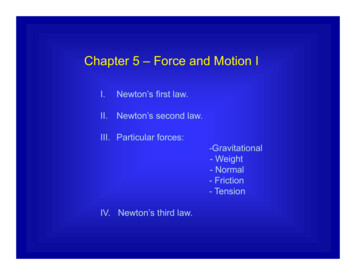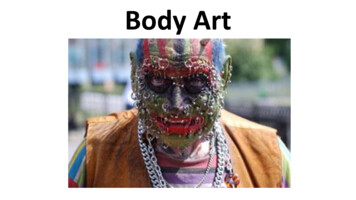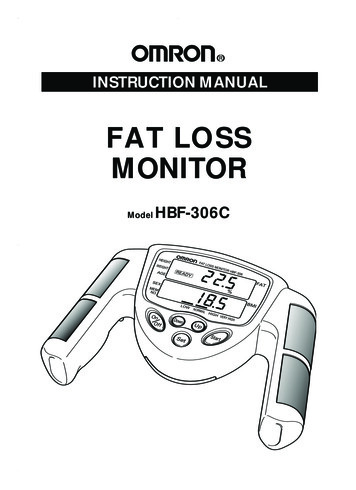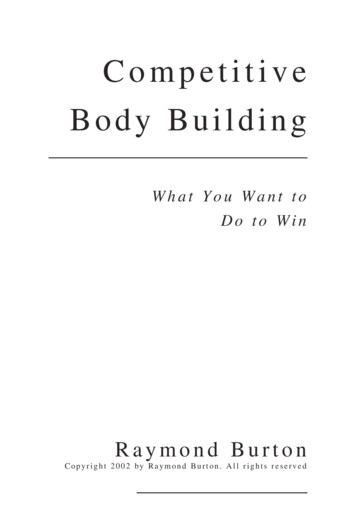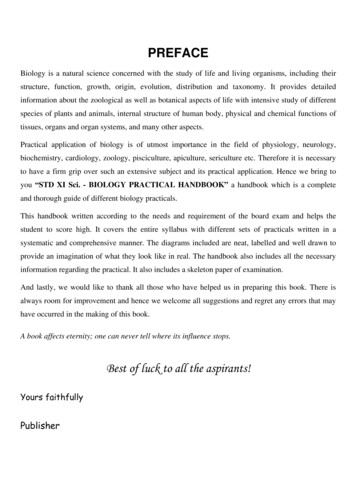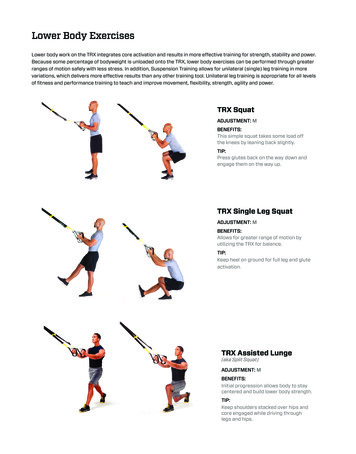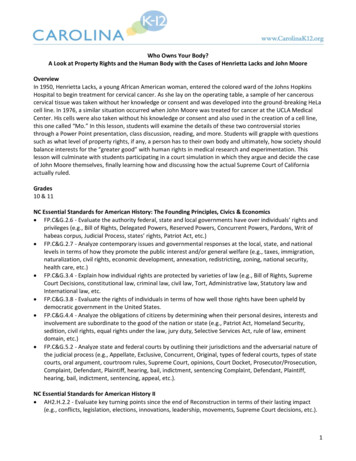
Transcription
Who Owns Your Body?A Look at Property Rights and the Human Body with the Cases of Henrietta Lacks and John MooreOverviewIn 1950, Henrietta Lacks, a young African American woman, entered the colored ward of the Johns HopkinsHospital to begin treatment for cervical cancer. As she lay on the operating table, a sample of her cancerouscervical tissue was taken without her knowledge or consent and was developed into the ground-breaking HeLacell line. In 1976, a similar situation occurred when John Moore was treated for cancer at the UCLA MedicalCenter. His cells were also taken without his knowledge or consent and also used in the creation of a cell line,this one called “Mo.” In this lesson, students will examine the details of these two controversial storiesthrough a Power Point presentation, class discussion, reading, and more. Students will grapple with questionssuch as what level of property rights, if any, a person has to their own body and ultimately, how society shouldbalance interests for the “greater good” with human rights in medical research and experimentation. Thislesson will culminate with students participating in a court simulation in which they argue and decide the caseof John Moore themselves, finally learning how and discussing how the actual Supreme Court of Californiaactually ruled.Grades10 & 11NC Essential Standards for American History: The Founding Principles, Civics & Economics FP.C&G.2.6 - Evaluate the authority federal, state and local governments have over individuals’ rights andprivileges (e.g., Bill of Rights, Delegated Powers, Reserved Powers, Concurrent Powers, Pardons, Writ ofhabeas corpus, Judicial Process, states’ rights, Patriot Act, etc.) FP.C&G.2.7 - Analyze contemporary issues and governmental responses at the local, state, and nationallevels in terms of how they promote the public interest and/or general welfare (e.g., taxes, immigration,naturalization, civil rights, economic development, annexation, redistricting, zoning, national security,health care, etc.) FP.C&G.3.4 - Explain how individual rights are protected by varieties of law (e.g., Bill of Rights, SupremeCourt Decisions, constitutional law, criminal law, civil law, Tort, Administrative law, Statutory law andInternational law, etc. FP.C&G.3.8 - Evaluate the rights of individuals in terms of how well those rights have been upheld bydemocratic government in the United States. FP.C&G.4.4 - Analyze the obligations of citizens by determining when their personal desires, interests andinvolvement are subordinate to the good of the nation or state (e.g., Patriot Act, Homeland Security,sedition, civil rights, equal rights under the law, jury duty, Selective Services Act, rule of law, eminentdomain, etc.) FP.C&G.5.2 - Analyze state and federal courts by outlining their jurisdictions and the adversarial nature ofthe judicial process (e.g., Appellate, Exclusive, Concurrent, Original, types of federal courts, types of statecourts, oral argument, courtroom rules, Supreme Court, opinions, Court Docket, Prosecutor/Prosecution,Complaint, Defendant, Plaintiff, hearing, bail, indictment, sentencing Complaint, Defendant, Plaintiff,hearing, bail, indictment, sentencing, appeal, etc.).NC Essential Standards for American History II AH2.H.2.2 - Evaluate key turning points since the end of Reconstruction in terms of their lasting impact(e.g., conflicts, legislation, elections, innovations, leadership, movements, Supreme Court decisions, etc.).1
AH2.H.4.1 - Analyze the political issues and conflicts that impacted the United States since Reconstructionand the compromises that resulted (e.g., Populism, Progressivism, working conditions and labor unrest,New Deal, Wilmington Race Riots, Eugenics, Civil Rights Movement, Anti-War protests, Watergate, etc.).AH2.H.8.1 - Analyze the relationship between innovation, economic development, progress and variousperceptions of the “American Dream” since Reconstruction (e.g., Gilded Age, assembly line,transcontinental railroad, highway system, credit, etc.).Essential Questions Who was Henrietta Lacks and how were her cells acquired and made into the “HeLa” cell line? What is special about the HeLa cell? What impact has the HeLa cell had on research, medical advancement, and society as a whole? Why did Henrietta and her family know nothing regarding how her cells were being used? Who was John Moore and how were his cells acquired and made into the “Mo” cell line? What was so special about John Moore’s spleen and cells? Why did John Moore sue the UCLA ? What was his argument? What decision did the Supreme Court of California make in Moore vs. the Regents of the University ofCalifornia? How does the case of John Moore compare to the case of Henrietta Lacks? How do research studies and clinical trials contribute to scientific knowledge? Describe the level of knowledge, expertise and work on the part of scientists that it takes to develop celllines such as HeLa and Mo. In what ways do current scientific research methods differ from those in the past? What level of property rights, if any, does a person have to their own body? Ultimately, how should society balance interests for the “greater good” and human dignity in regards tomedical research and experimentation?Materials “Who Owns Your Body,” accompanying Power Point; available in the Database of K-12 Resources (in PDFformat)o To view this PDF as a projectable presentation, save the file, click “View” in the top menu bar of thefile, and select “Full Screen Mode”o To request an editable PPT version of this presentation, send a request with lesson title toCarolinaK12@unc.edu Video of HeLa cells dividing: http://www.youtube.com/watch?v 2mOroGqJ Uko Teacher note: Many school districts block access to YouTube. Thus, teachers should download thevideo from a home machine if unable to access the clip at school. “Pioneers of Discovery - Henrietta's Dance,” article and questions attached Optional: Radio Lab’s “Henrietta’s Tumor,” a 25 minute radiocast available tas-tumoro If you are unable to access the link, send an e-mail request for the audio file to CarolinaK12@unc.edu “Who Owns John Moore s Spleen?,” article attached Optional: “The Man with the Golden Cells” video, available at:http://www.youtube.com/watch?feature player embedded&v R0o a4OgOWM.o Teachers can play from the beginning, or start the video at 3.23, when the information regarding theJohn Moore case starts; play till the end. The video then continues athttp://www.youtube.com/watch?v nV0j36T9wqM&feature relmfu. Play from the beginning and stopat 2.18 with “The justice system was about to have its say.” DO NOT play beyond this sentence;students should not hear the actual decision made before they conduct their own court simulation. Optional: “Who Told You You Could Sell My Spleen?” from “The Immortal Life of Henrietta Lacks,” byRebecca Skloot, pages199-203 Moore vs. the Regents of the University of California Fact Sheet Court Simulation Instructions: Moore vs. The Regents of the University of California2
Duration2 class periodsProcedureDay 1Introduction to the HeLa Cell1. As a warm-up, tell students to take out a sheet of paper. Play the brief 54 second video athttp://www.youtube.com/watch?v 2mOroGqJ Uk. Without giving students any information regarding thevideo, instruct them to write down any thoughts regarding what they see and what they think they areviewing. (A few phrases of text will pop up throughout the video that may offer hints to students.) Oncethe video ends, ask students to share their thoughts. It is likely the word “cell” will be brought up. Discuss: What is a cell?o Encourage students to think back to what they have learned in science classes regarding cells.Provide a very basic, brief overview/review, such as: The cell is the basic structural and functional unit of all known living organisms. It is thesmallest unit of life that is classified as a living thing, and is often called the building block oflife. Organisms can be classified as unicellular (consisting of a single cell; including mostbacteria) or multicellular (including plants and animals). Humans contain about 10 trillion cells. What appears to be happening to the cells pictured in the video? Can anyone identify anything specialabout the cells?o Explain to students that the video shows human cells dividing. In particular, the cells were takenfrom a woman named Henrietta Lacks in 1951. (Project her image on slide 3). The video showsHenrietta’s cells living and dividing outside her body at a rapid pace. The video is actually of a 27hour segment sped up, during which Henrietta’s cells divide, round up, grow hair, and then furtherdivide. Henrietta’s cells presented a breakthrough in science and medicine in 1951, because hercells multiplied outside the human body at a rate no one had ever seen before, reproducing anentire generation every 24hours. They were an “immortal cell-line,” with the special ability toproliferate continuously, without any mechanisms of prevention. Why do you think finding cells that could be grown and reproduced outside of the human body wouldbe so important to scientific and medical research?o Share that during the 1950s, scientist George Gey, head of tissue culture research at Johns Hopkinsand his wife Margaret were searching for a tool for the study of cancer: a line of human cells thatwould live indefinitely outside the body. If they succeeded, they could observe and test humancells in ways they could never do in humans. Eventually, they hoped they could discover the curefor cancer. However, up until 1951, no cells did very well growing outside of the human body. UntilHenrietta Lacks's cells came along and changed everything. Henrietta Lacks's cells multiplied likenothing anyone had seen. They latched to the sides of test tubes, consumed the medium aroundthem, and within days, the thin film of cells grew thicker and thicker. On October 4, 1951, GeorgeGey appeared on national television with a vial of Henrietta's cells. He called them HeLa cells, heldthem up to the camera, and said, "It is possible that, from a fundamental study such as this, we willbe able to learn a way by which cancer can be completely wiped out." (Source:http://www.jhu.edu/jhumag/0400web/01.html) Do you already know anything about Henrietta Lacks, her cells, and/or the history of how Henrietta’scells were discovered?o Tell students that in today’s lesson, they are going to be learning more about Henrietta and theHeLa cell. Tell students that while the HeLa cell has been used for much good in the world, thestory by which the HeLa cell came about is a complicated and controversial one.o Share some introductory information with students, such as: “In 1950, Henrietta Lacks, a young mother of five children, entered the colored ward of theJohns Hopkins Hospital to begin treatment for an extremely aggressive strain of cervicalcancer. As she lay on the operating table, a sample of her cancerous cervical tissue was taken3
without her knowledge or consent and given to Dr. George Gey, the head of tissue research.[As just discussed,] Gey was conducting experiments in an attempt to create an immortal lineof human cells that could be used in medical research. Those cells, he hoped, would allowscientists to unlock the mysteries of cancer, and eventually lead to a cure for the disease. Untilthis point, all of Gey’s attempts to grow a human cell line had ended in failure, but Henrietta’scells were different: they never died. Less than a year after her initial diagnosis, Henriettasuccumbed to the ravages of cancer and was buried in an unmarked grave on her family’s land.She was just thirty-one years old. Her family had no idea that part of her was still alive,growing vigorously in laboratories—first at Johns Hopkins, and eventually all over the world.”(Source: /RHSklootTeachersGuideLORES.pdf)Pioneers of Discovery - Henrietta's Dance2. Project slide 4 and tell students they are going to begin learning about this controversial piece of history byfirst reading “Pioneers of Discovery - Henrietta's Dance.” Hand out the article and corresponding questions(attached) and instruct students to carefully read the text, taking notes as they read: Circle any words that are unfamiliar to you. Underline any parts of the article that you think are most important or that stick out to you. If you are confused by any part of the excerpt, write a question mark by that line or section. You canalso write out questions on the text. If anything surprises you or evokes a strong emotional response from you, you can write anexclamation mark by the line or section, If a particular thought pops in your head that connects to the reading, write it in the margins.3. Once students have completed the reading, teachers should either instruct them to answer thecorresponding questions individually or in small groups, or teachers can debrief the questions as a wholeclass. (If students first answer individually or in small groups, teachers should reserve time to address thelast five questions in depth as a class.) What was the symptom that caused Henrietta to go to the doctor? When she was examined, what didthe doctor’s find? What did the doctors use as an attempt to cure Henrietta’s disease? How has cancer treatmentprogressed? What leads to such progressions in medical treatments? Why did George Gey collect human cell samples? What was his goal? What impact did Henrietta’s cells have on polio?o See #4 below, and slides 6-10 of the accompanying PPT for additional information regarding theimpact of HeLa cells on polio. Why did facilities start mass producing Henrietta’s cells (named HeLa cells?) As Henrietta’s cells were shared with various labs, what other studies were her cells used for? Why did Henrietta’s family know nothing regarding how her cells were being used? How did Henrietta’s family first learn about how Henrietta’s cells were being used (24 years afterHenrietta’s death)? Why were they so confused by this? What made HeLa cells so special? Why did scientists from Johns Hopkins finally decide to contact the Lacks family? Why did the Lacks family agree to provide the requested blood samples? Even when the Lacks family was finally contacted, why do you think none of the researchers took thetime to explain anything to them regarding Henrietta’s cells? What are some of the changes in scientific research standards/requirements that have been made,since the doctors took the cells from Henrietta? Why was the Presidential Bioethics Advisory Commission formed? Beyond this article, Rebecca Skloot also wrote a book regarding HeLa cells, called “The Immortal Life ofHenrietta Lacks.” Why do you think she feels it is important to bring attention to this story? In your opinion, were Henrietta and her family mistreated by the medical profession? Explain.4
Given that Henrietta Lacks and her family are African American, in what ways might the time period(the 1950s, when segregation was still legal and Jim Crow ingrained in society) have affected thissituation? In addition to being African American, do you think the fact that Henrietta and her familywas/are poor impacted the way events played out?What positive impact has the medical industry’s actions regarding Henrietta’s cells had on each of us?Skloot writes, “Since the development of the HeLa cells, there's been an explosion of both scientificand commercial interest in the use of human tissues for research purposes, yet research subjectsgenerally see none of the returns.” Should Henrietta’s family be compensated in some way for hercells and the impact they have had on research? Why or why not?o This quote is located on slide 5 of the accompanying PPT which can be projected during discussion.4. Discuss with students how it was the HeLa cells’ impact on creating a vaccine for polio that first garneredits attention and popularity. Go through the information on slides 6-10 with students to provide a bit moredetail regarding polio and the HeLa cells’ impact on the disease. What are the positive impacts that Henrietta’s Lacks’s cells have had on society, including on each ofus? Describe the level of knowledge, expertise and work on the part of scientists that it took to developthe HeLa cell. Why is this story so complicated? (Discuss with students how it’s hard to balance the benefits thecreation of the HeLa cell have had on society with the treatment - i.e., lack of informed consent andlack of information shared - of Henrietta and her family. It’s not necessarily “cut and dry” on eitherside.Optional 25 Minute Activity: Radio Lab’s “Henrietta’s Tumor”5. To provide additional details for students, some of which are shared by Rebecca Skloot, author of theImmortal Life of Henrietta Lacks, as well as some of the people actually involved in the HeLa story, playRadio Lab’s “Henrietta’s Tumor” for students, a 25 minute radiocast available tumor/. (Please note that the file is audio only.) Playthe file from the beginning, stopping and discussing as directed below: Stop at 7.18 and discuss: Why did Henrietta Lacks go to Johns Hopkins hospital in 1951? How did George Gey end up with a sample of Henrietta’s tumor? What was the main mission of George Gey and other scientists at the time? Why did scientists so badly wanted to be able to successfully grow human cells outside of thehuman body? Up until Henrietta’s cells were introduced, what problem had scientists encountered in trying togrow cells? What happened to Henrietta? What happened to her cells? What turned out to be special about Henrietta’s cells? Continue playing, stopping at 12:27 then discuss: Why did George Gey send his employee Mary back to the Johns Hopkins morgue? Why couldn’t Mary look at Henrietta’s body? Why was she so struck by Henrietta’s nail polish?Why do you think many people working in fields such as science and medicine try to distancethemselves from the human lives connected in various ways to the work they are doing? What did George Gey do with the hundreds of thousands of HeLa cells he produced and why? Why were HeLa cells important to the polio epidemic? What role did the Tuskegee Institute play in using HeLa cells to help create a polio vaccine? In addition to polio, what other diseases were HeLa cells mass produced to study? Why did HeLa cells get sent into space?o For an additional reading on the mass production and uses of the HeLa cells, see “TheImmortal Life of Henrietta Lacks,” Chapter 13: “The HeLa Factory” (p. 93-104). Continue playing, stopping at 17.10 then discuss:5
What lead scientists to finally contact the Lacks family 25 years after Henrietta’s death?How was Deborah impacted by her mother’s death?How do you infer Deborah felt in 1973 when scientists called to request blood samples from theliving Lacks family members? Why was she under the misconception that her mother had been cloned? Stop the recording at 25.10 and discuss: What was Henrietta Lacks like (in terms of appearance, personality, etc.)? What was Henrietta’s death like? What was Deborah’s worry in regards to her mother’s cells? Why hadn’t anyone explained thescience to her? How do you think all the worry and misunderstanding impacted Deborah? What do you imagine it was like for Deborah to see her mother’s cells for the first time?Culminating Discussion & Activity6. Culminate with a class discussion: Bearing in mind that the tissue samples removed from Henrietta were not removed in an attempt totreat her cancer, but rather for purposes of research, do you feel it was unethical for the doctor toremove the sample tissue in the first place? Does the end – i.e., the benefit to society resulting fromthose tissue samples (i.e. the polio vaccine, etc.) – justify the means – (i.e., removing tissue from aperson without their consent or knowledge)? Do you think that Henrietta’s race played a part in how the removal of her cells played out? (Meaning,did you get the impression that Henrietta was treated any differently than a well off, white womanwould have been treated?) Why has the discovery of the existence of HeLa cells been so difficult for the Lacks family? (Discuss thefamily’s having been kept out of the loop, the vague details that trickled to them second hand, theirlack of medical knowledge to understand what they did hear, etc.) Why did it take until 2001, 50 yearsafter Henrietta’s death, for a researcher at John Hopkins to show Deborah the cells and explain whatthey were? Consider Ruth Faden’s comment: "’There are at least two issues that cases like Mrs. Lacks's raise,’"says Ruth Faden, executive director of the Johns Hopkins Bioethics Institute and the Philip FranklinWagley Professor of Biomedical Ethics. "One is the question of consent, and the other is what, ifanything, is morally or legally due to a person if something of commercial value is developed fromtheir cells.’" Do you think the family is owed money for the sale of the HeLa cells? Do you agree withtheir feeling that they should be compensated? What might be complicated about offering patients money for donations of their cells? Overall, what life lessons can be learned from this account? Optional: As a culminating assignment, remind students once again that a recent book was written aboutHenrietta Lacks and the creation of the HeLa cell, called “The Immortal Life of Henrietta Lacks.” Tellstudents to imagine that the author, Rebecca Skloot, has asked them to design the cover for the book.Using their knowledge of the story of Henrietta Lacks and the HeLa cell, while considering all of the layersto the story, students should design a cover for the book on 8 ½ x 11 paper that includes an image andtext. The cover should be appropriate to the circumstances of the story and also make readers want toread the book based on its design.Day 27. As a warm-up, have students post their book covers around the class upon entering. Once all covers arehung, instruct students to conduct a five minute gallery walk in which they travel around the room andexamine the various book covers. Instruct students to choose one cover (not their own) that they feel doesa particularly skilled job at representing the story of Henrietta Lacks. After five minutes, have somevolunteers share which cover they felt is most effective and why. Use this as an opportunity to also pose6
review questions regarding what students learned the previous day about Henrietta Lacks and the HeLacell.The Case of John Moore and the “Mo” Cell Line8. Next, tell students that they are going to further consider the issues raised in the story of the HeLa cell byconsidering a similar situation that took place around twenty years later, in 1976, with a man named JohnMoore. Like Henrietta, John’s cells were taken and used in the creation of a cell line (this one called “Mo”)without his knowledge. However, unlike Henrietta’s situation, John Moore found out and sued the doctor.Explain that they are going to be examining and reenacting the case of John Moore today in class.9. Begin by providing some background information regarding John Moore’s case by using slides 11-16 of theaccompanying PPT. Encourage students to take notes. (The information shared on these slides is alsoavailable on the attached “Facts of the Case” handout should teachers want to provide this to students.)After sharing the information, allow students to ask any questions they currently have, but refrain fromhaving a class discussion in which students share their opinions of the circumstances at this point. (Therewill be time for this after the court simulation.)10. Next, provide students with the attached article, “Who Owns John Moore s Spleen?,” which was written inFebruary 1990, right before the California Supreme Court made a decision regarding this case. Instructstudents to carefully read the article, reminding them that they will need this information in the upcomingcourt activity they will be participating in. After students have finished reading, discuss as a class: What was so special about John Moore’s spleen and cells? How might society be negatively impacted if a person with special cells (i.e., cells that could help leadto curing various diseases) is asked to donate those cells but they say no? How much knowledge and work do you imagine it took on Dr. Golde and his team at the University ofCalifornia to create the “Mo” cell line? In what ways did Dr. Golde profit from the Mo cell line? In what ways did John Moore profit from theMo cell line? In what ways might society as a whole profit from the Mo cell line? Why did Moore sign the surgical consent form? Why did he initially sign the form provided by Golde’soffice regarding giving up his rights to any cell line created? Why did he then change his mind? Why did John Moore sue? What is his argument? What is the legal team for Dr. Golde and the University of California’s argument against John Moore’scase? How might medical research be impacted (positively and/or negatively) if the California Supreme Courtmakes a decision in favor of John Moore? Likewise, how might individual patients be impacted(positively and/or negatively) if a decision is made in favor of John Moore? What is the National Organ Transplant Act (1984)? What does current law say regarding human property rights in terms of one’s body? Since most research scientists don’t get rich off of cell research, why are they doing this work? Why do many hospitals refuse to incorporate waivers relating to royalty payments into their surgicalconsent forms? In sum, what are the ultimate questions the California Supreme Court must decide in this case?o Make sure students are aware of these three major issues, in addition to any others they maybring up: What level of property rights, if any, does a person have to their own body? (i.e., it’s illegal forsomeone to remove a healthy organ from me to sell it, but it’s not illegal for medical facilitiesto use medical waste after my surgery for experimentation) Did John Moore waive all rights to his cells when signing the medical release form for thesurgical removal of his spleen? Is John Moore owed compensation based on the commercial development of his cells by Dr.Golde and the University of California?7
11. Additional/optional information to share with students: “The Man with the Golden Cells”: Additional information regarding the case is available via a briefvideo, “The Man with the Golden Cells,” available at:http://www.youtube.com/watch?feature player embedded&v R0o a4OgOWM. Teachers can playfrom the beginning, or start the video at 3.23, when the information regarding the John Moore casestarts; play till the end. The video then continues athttp://www.youtube.com/watch?v nV0j36T9wqM&feature relmfu. Play from the beginning and stopat 2.18 with “The justice system was about to have its say.” DO NOT play beyond this sentence;students should not hear the actual decision made before they conduct their own court simulation.o Teacher note: Many school districts block access to YouTube. Thus, if planning to utilize thesevideo clips, teachers may need to download the files from a home computer first. “Who Told You You Could Sell My Spleen?”: Another detailed reading is Chapter 25 of Rebecca Skloot’sbook, “The Immortal Life of Henrietta Lacks.” Have students read pages 199-203 of the chapter,stopping after 3rd paragraph, ending with “With that, he became the first person to legally stake aclaim to his own tissue and sue for profits and damages.” (Make sure students do not read furtherthan this sentence, since the remainder of the chapter discusses the Supreme Court of CA’s decision.Students can finish pages 203-206 of the chapter at the end of the lesson if desired.)CA Supreme Court Simulation: Moore v. Regents of the University of California12. Remind students that the initial local lawsuit Moore filed never went to trial. Explain that the Los AngelesCounty Superior Court dismissed it, indicating that because Moore had no property rights to his cells, hehad no case. Moore s attorneys appealed to the California Court of Appeal, which reversed the lowercourt s ruling in July 1988. It said Moore did have property rights to his own body. Furthermore, the courtsaid Moore hadn t waived those rights to his spleen when he signed a form consenting to its surgicalremoval, and hadn t agreed to commercial development of his cells by consenting to the surgery or to themedical research that followed. The University of California appealed the ruling to the Supreme Court, inMoore vs. the Regents of the University of California.13. Explain to students that they are going to be determining the outcome of this case themselves. Dividestudents into groups of 3-5, with an equal number of each type of the following three groups. (Letstudents know that they may get assigned to a side they don’t necessarily agree with. Explain that they willhave a chance to share their own personal opinions at the end of the activity. Legal team for John Moore; these students will argue points such as:o the decision of the California Court of Appeal should be upheld,o Moore does have property rights to his own body, which were violated by Dr. Golde and hisemployer, the University of Californiao Moore hadn t waived his rights to his spleen when he signed a form consenting to its surgicalremoval, and he never agreed to commercial development of his cells by consenting to the surgeryor to the medical research that followed.o Moore is owed compensation since Dr. Golde and the University profited from his stolen cells Legal team for Dr. Golde and the University of California medical center; these students will argue pointssuch as:o The decision of the Califor
from a woman named Henrietta Lacks in 1951. (Project her image on slide 3). The video shows Henrietta’s cells living and dividing outside her body at a rapid pace. The video is actually of a 27 hour segment s



